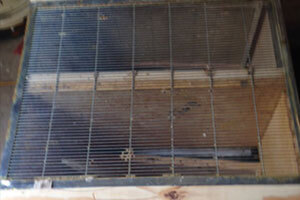
It has been busy this spring, thinking about how to cover my Two-queen Horizontal bee hive. First, the inner covers are to be considered. When the two-queen horizontal hive is in use, the queens must be separated by a queen excluder. The queen excluder separates the two queens while allowing the workers from both colonies into supers above. The wood frame excluder cannot be used for this purpose; there is bee space under that type excluder. The queen on one side will eventually find the other queen on the other side and a single queen colony will result. Therefore, a flat metal bound excluder is the only type that will work on this hive. I reject the plastic excluders for this purpose because they are prone to break eventually, when left on a hive for long periods of time. Broken excluders allow a queen to pass through.
The inner covers for a Two-Queen Horizontal Hive could be simple side-by side inner covers without holes. However, these types of covers will not work when the excluder is in place to prevent queens from meeting in the supers. Since I plan to use the fondant feeders, explained in last month’s column to feed these two queen colonies, a queen excluder will be on the two-queen colony most of the time. Therefore, the solution is two half-size inner covers. My two inner covers are made of a single sheet of plywood with numerous ventilation holes drilled into the tops. Ventilation will be important for this type of two-queen colony because there are more bees, (two clusters) and more heat to dissipate.
There will be times when such a two-queen colony will not have a queen excluder in the center between the two half-sized inner covers. The other half of that inner cover could be used to replace the excluder during those times. It could be a standard inner cover without holes. However, a standard inner cover has bee space for queens to pass through. That brings us back to a single sheet of plywood the size of an inner cover. This could work, but I did not choose this option. It seems that on many occasions when examining this two-queen colony, a beekeeper might want to go through one colony at a time. So, that brings us back to another set of half-size inner covers made of plywood. We are now up to four total half-size inner covers. As you see, Two-queen Horizontal Bee Hives are more complicated and do require extra equipment. Do not forget that a fondant feeder made with a plastic queen excluder will be another inner cover. The plastic excluder used under the fondant feeder board is replaceable and most easily used for feeders. The metal bound queen excluder used below supers is yet another inner cover. That brings us up to a total of six inner covers.
We could put two standard, bottom boards together for the bottom board, but I elected to make a single bottom board with a divider. Telescoping covers cannot be simply joined to make a single top. Since the two brood chambers are joined, each colony cannot have an individual telescoping cover. It would be possible to build a single two-queen horizontal bee hive telescoping cover with two standard wooden outer covers. One telescoping side board could be left out of each side of those individual covers and the two joined in the center to cover the entire two-queen horizontal colony. That was actually my original plan. However, I had an extra sheet of plywood on hand left over from another project. I made a single cover 22 inches wide and 35 inches long.
Economy was not the only part of the decision. These Two-queen Horizontal Bee Hives are heavy. They are probably not going to be moved; these hives are not for migratory beekeeping. A heavy cover is not that much of a bother. The cover will weigh a lot less than a shallow super full of honey. When the fondant feeder boards are on these colonies, the plywood inner covers and the feeder will be different heights. The solution is to use 1 x 4 lumber for the sides instead of 1 x 2. Many of you will remember that I talked of not cutting 45 degree angles on the 1 x 2 boards I use to make screen bottom boards. When using 1 x 4 stock, a 45 degree joint is preferred. It is stronger when glued. With a miter saw, 45 degree corners are not that difficult to cut.
When cutting the telescoping cover, make sure the box fits over the hive in question. It does not need to be a tight fit. An outer cover with 1 x 4 sides that fits over a horizontal two-queen colony is heavy enough to …


